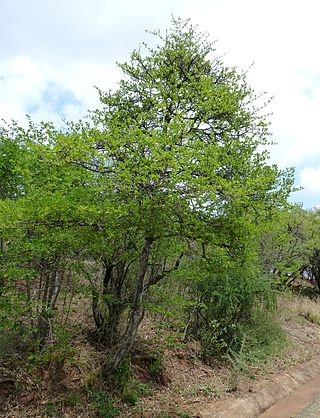Bullockia is a genus of flowering plants in the family Rubiaceae. It was originally described as a subgenus of Canthium. The genus is distributed in eastern and southern Africa from Ethiopia to Transvaal, as well as Madagascar in bushland, woodland, savannas, and dry, deciduous forests.

Canthium is a genus of flowering plants in the family Rubiaceae. They are shrubs and small trees. The leaves are deciduous and the stems are usually thorny.
Afrocanthium keniense is a species of flowering plant in the family Rubiaceae. It is endemic to Kenya. It is threatened by habitat loss.

Lagynias was a genus of flowering plants in the family Rubiaceae but is no longer recognized. In 2005, it was sunk into synonymy with Vangueria, based on a phylogenetic study of DNA sequences.

Psydrax is a genus of flowering plants in the family Rubiaceae. It consists of trees, shrubs, and a few lianas in the paleotropics.
Robynsia is a monotypic genus of flowering plants in the family Rubiaceae. It was described by John Hutchinson and was named after his friend and colleague Walter Robyns. The genus contains only one species, Robynsia glabrata, which is found in Ghana, Ivory Coast and Nigeria. The species is morphologically similar to the genus Cuviera but differs by having long, slender corolla tubes.
Temnocalyx is a monotypic genus of flowering plants in the family Rubiaceae. It was originally described by Walter Robyns in 1928 and contained five species. Since then most of these species have been made synonym and currently only one species name remains valid, i.e. Temnocalyx nodulosa. The species is endemic to southwestern Tanzania.

Vangueria is a genus of flowering plants in the family Rubiaceae. The genus is named for Voa vanguer, as V. madagascariensis is known in Malagasy.
Vangueriopsis is a genus of flowering plants in the family Rubiaceae.

Vanguerieae is a tribe of flowering plants in the family Rubiaceae and contains about 655 species in 30 genera. It is one of the most species-rich groups within the family and it is distributed across the Paleotropics.

Fadogia is a genus of flowering plants in the family Rubiaceae. The genera Rytigynia and Fadogia form a strongly supported clade but neither of these genera is monophyletic.

Afrocanthium is a genus of flowering plants in the family Rubiaceae. It consists of deciduous, unarmed trees, and shrubs. They are native to East Africa, from Sudan and Ethiopia to South Africa.
Hutchinsonia is a genus of flowering plants in the family Rubiaceae. It was described by Walter Robyns in 1928 and was named after his friend and colleague John Hutchinson. It is found in west tropical Africa.
Eriosemopsis is a monotypic genus of flowering plants in the family Rubiaceae. It was described by Walter Robyns in 1928 and no changes have been made since then. The genus contains only one species, viz. Eriosemopsis subanisophylla, which is native to southeastern Eastern Cape and southern KwaZulu-Natal provinces of South Africa. The species is morphologically similar to the species Pygmaeothamnus zeyheri but differs by having a thick indumentum, raised venation and elliptical leaves.

Meyna is a genus of flowering plants in the family Rubiaceae.
Pygmaeothamnus is a monotypic genus of flowering plants in the family Rubiaceae. It was described by Walter Robyns in 1928 and originally held four species. It is found in central and southern Africa.
Fadogiella is a small genus of flowering plants in the family Rubiaceae. It was described by Walter Robyns in 1928.
Ancylanthos was a genus of flowering plants in the family Rubiaceae but is no longer recognized. It was originally described by René Louiche Desfontaines in 1818. In 2005, it was sunk into synonymy with Vangueria, based on a phylogenetic study of DNA sequences.
Kanapia is a genus of flowering plants in the family Rubiaceae. The genus is endemic to the Philippines. It was described when two former Canthium species were transferred to this new genus.








